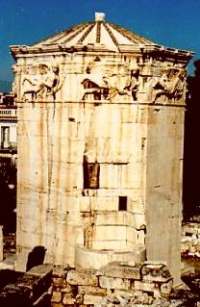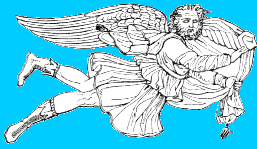Weather Journal
Greek Tower of the Winds

 In an old Roman marketplace located in Athens, Greece not far from the famed Parthenon stands a structure known as the "Tower of the Winds." In an old Roman marketplace located in Athens, Greece not far from the famed Parthenon stands a structure known as the "Tower of the Winds."
Constructed around 50 BCE, by the Greek architect and astronomer Andronikos of Kyrrhos, it combined sundials, a complicated internal water clock, and a weathervane many historians cite as the first ever built. The octagonal, white marble Tower stands over 12 metres (46 feet) high with a diameter of about 8 metres (26 feet), resting on a base of three steps.
 The Tower was originally topped by a revolving bronze weather vane which we know from historical records to have been of the sea god Triton, who had the head and torso of a man and the tail of a fish. A pointed wand in his hand indicated the direction from which the wind was blowing. Considering the Greeks' sense of architectural proportion, the Triton vane likely measured from 1.2-2.5 metres (4-8 feet) long to look proper atop a 12 metre (forty-five-foot) high structure. The Tower was originally topped by a revolving bronze weather vane which we know from historical records to have been of the sea god Triton, who had the head and torso of a man and the tail of a fish. A pointed wand in his hand indicated the direction from which the wind was blowing. Considering the Greeks' sense of architectural proportion, the Triton vane likely measured from 1.2-2.5 metres (4-8 feet) long to look proper atop a 12 metre (forty-five-foot) high structure.
 To the ancients, the winds had divine powers. The Tower, made of local marble, is decorated on each side with a sculpted figure of the wind deity ruling the compass point to which it faces. Each winged figure personified the character of its wind direction. For example, on the north side, Boreas, dressed in a heavy cloak, blows through a twisted conch shell, signifying the cold character of the North Wind. The following table describes all eight of the wind dieties. To the ancients, the winds had divine powers. The Tower, made of local marble, is decorated on each side with a sculpted figure of the wind deity ruling the compass point to which it faces. Each winged figure personified the character of its wind direction. For example, on the north side, Boreas, dressed in a heavy cloak, blows through a twisted conch shell, signifying the cold character of the North Wind. The following table describes all eight of the wind dieties.
| Wind Direction | Wind Diety | Sculpted Character |
| North | Boreas | a man wearing a heavy cloak, blowing through a twisted conch shell |
| North East | Kaikias | a man carrying and emptying a shield full of small, round objects, perhaps, hailstones |
| East | Apeliotes | a young man holding a cloak full of fruit and grain |
| South East | Euros | an old man wrapped tightly in a cloak against the elements |
| South | Notos | a man emptying an urn and producing a shower of water |
| South West | Lips | a boy pushing the stern of a ship, promising a good sailing wind |
| West | Zephyros | a youth carrying flowers into the air |
| North West | Skiron |
a bearded man carrying a bronze pot full of hot ashes and charcoal |
In the early Christian period, the Tower of the Winds was converted into a church. Half-buried by earth accumulating over the centuries, the Tower was excavated around 1840 and restored during the last century. Today it is a popular tourist attraction in Athens.
"Some have chosen to reckon only four winds, the East blowing from the equinoctial sun-side, the South from the noonday sun, the West from the equinoctial sun-setting, and the North from the polar stars. But those who are more exact, have reckoned eight winds, particularly Andronicus Cyrrhestes, who on this system erected an octagon marble tower at Athens, and on every side of the octagon, he wrought a figure in relievo, representing the wind which blows against that side; the top of this tower he finished with a conical marble, on which he placed a brazen triton, holding a wand in his right hand; this triton is so contrived that he turns round with the wind, and always stops when he directly faces it: pointing with his wand, over the figure of the wind at that time blowing." — Roman architect Marcus Vitruvius |
Learn More From These Relevant Books
Chosen by The Weather Doctor
Written by
Keith C. Heidorn, PhD, THE WEATHER DOCTOR,
January 10, 2003
The Weather Doctor's Journal Greek Tower of the Winds
©2003, Keith C. Heidorn, PhD. All Rights Reserved.
Correspondence may be sent via email to: see@islandnet.com.
For More Weather Doctor articles, go to our Site Map.

I have recently added many of my lifetime collection of photographs and art works to an on-line shop where you can purchase notecards, posters, and greeting cards, etc. of my best images.

Home |
Welcome |
What's New |
Site Map |
Glossary |
Weather Doctor Amazon Store |
Book Store |
Accolades |
Email Us
|



|








